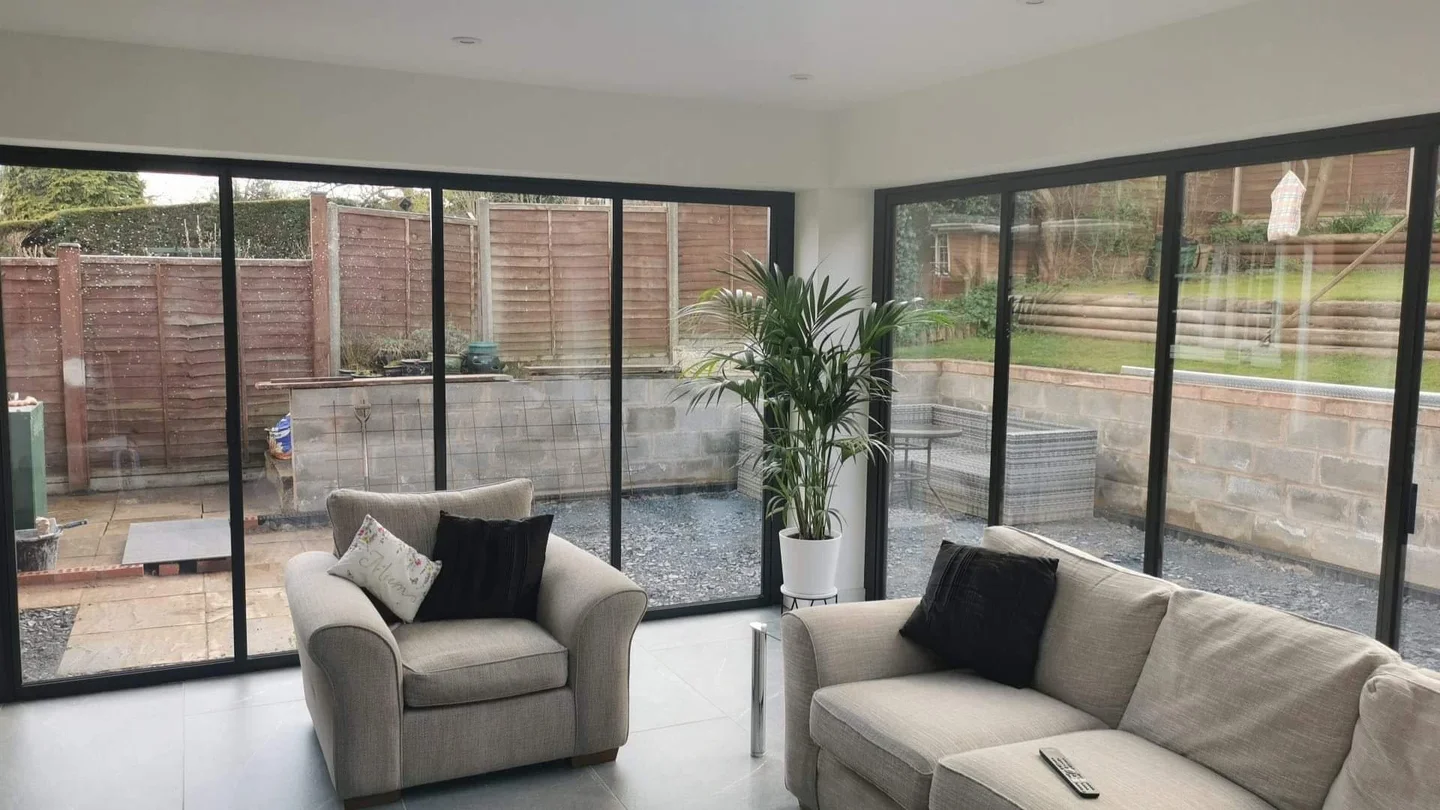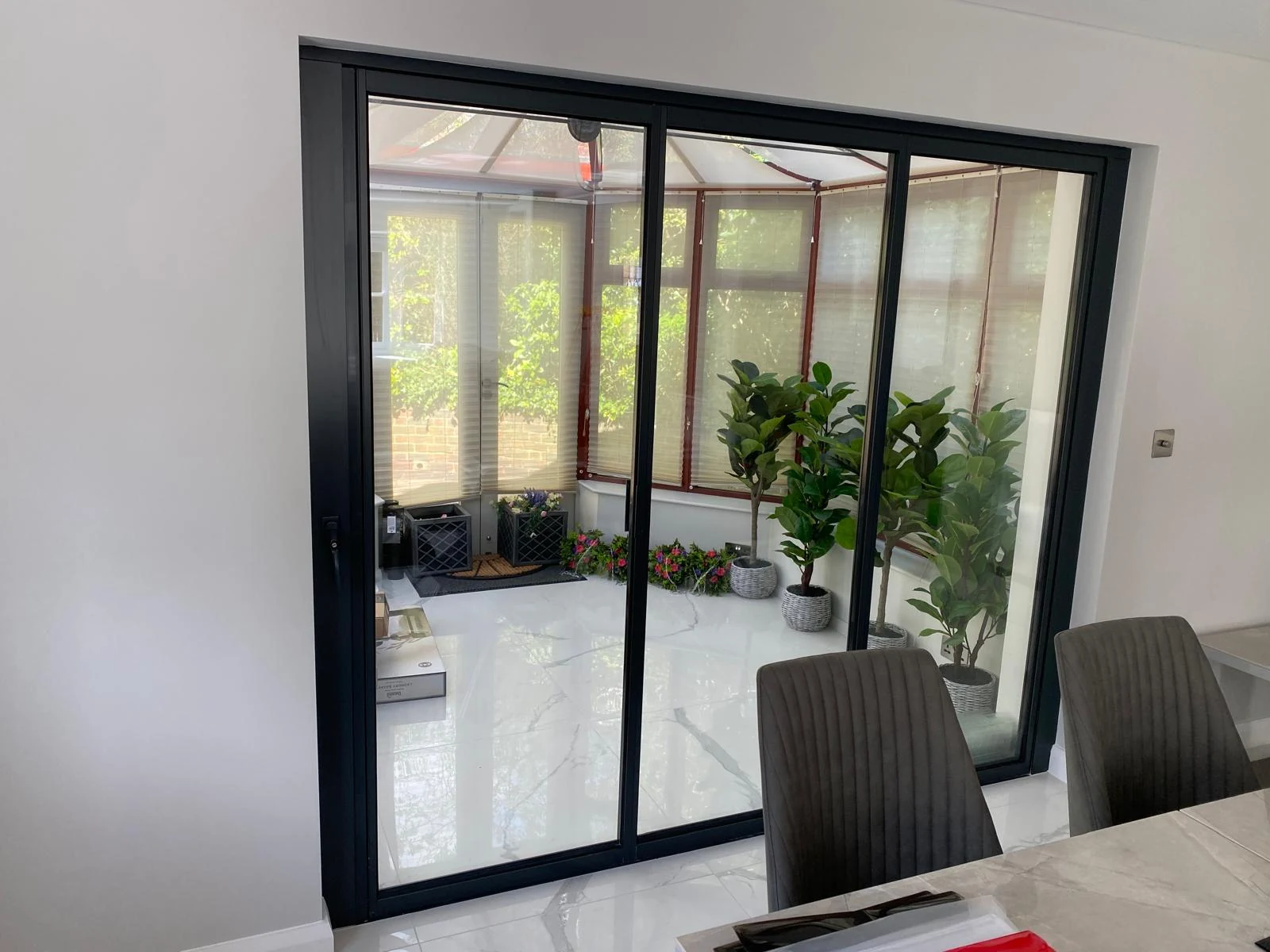Black Frame Bifold Doors: Complete Buyer’s Guide
Table of Contents

Black Frame Bifold Door Materials and Finishes
Modern black frame bifold doors blend striking visual appeal with robust performance. Material quality determines not just how long your doors will last, but also how they’ll look years down the line.
Why Aluminium Works Best for Black Frames
Aluminium stands out as the prime material for black frame bifold doors thanks to its remarkable strength-to-weight ratio. Unlike PVC or timber frames, aluminium can support larger glass panels while maintaining slim sightlines. The rigidity of aluminium prevents warping or sagging, a particular advantage when choosing jet black finishes that would highlight any imperfections.
Manufacturing processes for aluminium frames allow for precise corner joints and clean lines that match contemporary architectural designs. The material’s natural resistance to corrosion, paired with proper surface treatment, means black framed bifold doors maintain their rich colour even in challenging weather conditions.

Powder Coated vs Anodised Black Frames
Powder coating creates a tough outer skin on bi-folding doors through an electrostatically applied powder that’s heat-cured. The process allows for different textures and sheens, from subtle matt to high gloss. Quality powder coating should last decades with proper care, though harsh coastal conditions might need more frequent maintenance.
Anodising offers a different approach by chemically bonding the black finish into the aluminium itself. This method produces black framed bi fold doors with outstanding scratch resistance and a distinctive metallic depth that many architects favour. The finish won’t chip or peel since it’s part of the metal structure rather than a surface coating.
Textured vs Smooth Black Finishes
Textured black surfaces mask minor scratches and fingerprints better than smooth alternatives. The micro-texture creates subtle light play across bi-fold doors, adding visual interest while reducing maintenance frequency.
Smooth finishes showcase the clean lines of black frame bifold doors with striking clarity. They work particularly well in minimalist spaces where every detail matters. Regular cleaning keeps these surfaces looking pristine, though they do tend to show dust more readily than their textured counterparts.
Finish Durability Guide
Surface hardness varies widely between different black finishes. Marine-grade powder coating offers excellent protection in coastal areas, while Class 2 anodising provides superior wear resistance for high-traffic areas. The initial investment in premium finishes often pays off through reduced maintenance and longer-lasting good looks.
Exterior Design With Black Frame Bifold Doors
The strong visual statement of black frame bifold doors makes them particularly suited to modern and contemporary architecture. Their bold lines can define a building’s character, turning what might be an ordinary opening into a striking architectural feature.
Black Frames and Building Style
Modern glass houses and converted industrial spaces pair naturally with black framed bifold doors, where the dark frames echo structural elements and create visual rhythm across the facade. A Georgian property might benefit from slimline bifold doors with traditional panel configurations that mirror the proportions of original sash windows. In contrast, the clean lines of mid-century modern homes work best with wider glass panels and minimal frame divisions.
Raw brick and exposed steel structures gain fresh sophistication when paired with black frame bifold doors. The industrial heritage of these materials creates a coherent design language, while the doors’ clean lines prevent the overall look from becoming too utilitarian. Rendered walls in cool greys or warm whites provide an ideal backdrop, letting the strong horizontals and verticals of the frames stand out.
Stone-built properties require careful thought when installing black framed bi fold doors. Local building materials often carry warm undertones that might clash with certain black finishes. Choosing frames with a softer black tone or slight texture can help marry modern doors with traditional materials.
Impact on Exterior Symmetry
Black frame bifold doors command attention, making them ideal focal points for facade design. Their strong linear elements can introduce order to asymmetrical buildings or strengthen existing architectural geometry. Narrow bifold doors can work well in pairs, creating balanced compositions that draw the eye across the building’s width.
The vertical elements of door frames can establish visual links between ground floor openings and upper windows. This vertical emphasis helps unify split-level properties and creates pleasing proportions across different storeys. Frame spacing affects the overall rhythm of the facade – wider glass panels suit broad, horizontal buildings while multiple smaller panels complement taller, narrower properties.
Frame Configuration Principles
Door leaf sizes and frame divisions need careful planning to maintain proportional harmony. The number of panels should relate to the width of the opening – too many divisions can look busy, while too few might appear out of scale. Black framed bi fold doors often work best with an odd number of panels, allowing a central opening that maintains symmetry when the doors are partially open.

Landscape Design for Black Frame Bifold Doors
Outdoor spaces should complement the strong geometric presence of black frame bifold doors through thoughtful material selection and layout. Grey stone paving creates subtle contrast without competing for attention, while dark decking builds on the door frames’ linear quality. Including plants with architectural forms – think ornamental grasses or sculptural evergreens – helps soften the hard edges without hiding them.
Hard landscaping materials near the doors influence how light reflects into interior spaces. Light-coloured paving bounces sunlight inside, while darker surfaces absorb it. This interaction becomes particularly important in north-facing installations where black framed bifold doors might otherwise reduce natural light levels.
The visual weight of black frames needs balancing in the wider garden design. Strategic placement of darker elements – perhaps charcoal rendered walls or black limestone – creates connections between the doors and outdoor spaces. Moving away from the building, gradually lightening the palette prevents the scheme from feeling heavy-handed.
Garden lighting takes on extra importance with black frame bifold doors. Uplighting nearby architectural plants draws attention to the contrast between solid frames and transparent glass after dark. Well-placed spotlights can highlight the doors’ strong lines while avoiding unwanted reflections that turn glass into mirrors at night.
Interior Spaces and Black Frame Bifold Doors
Striking the right balance between statement and subtlety defines successful interior design with black frame bifold doors. Their strong linear elements shape how we perceive space, creating visual anchors that guide the eye through a room.
Room Scale and Visual Weight
Glass walls with black frames appear lighter than solid walls while maintaining clear spatial division. In smaller rooms, black framed bifold doors draw attention to the full height and width of the opening, making the space feel larger through strong vertical lines. The contrast between dark frames and clear glass creates depth, pushing the perceived boundaries of the room outward.
Dark frames against light walls establish strong architectural rhythm. This interplay works especially well in double-height spaces, where black framed bi fold doors can emphasize the vertical dimension without overpowering the room. The proportion of frame to glass becomes particularly important – thicker frames make bolder statements but might dominate smaller spaces.
Natural light interacts differently with black frames throughout the day. Morning sun casts crisp shadows that track across the floor, while evening light silhouettes the frames against bright skies. These changing patterns add dynamic interest to interior spaces, though they require careful planning of furniture layout to avoid unwanted glare or dark spots.

Using Black Frames as Room Dividers
Black internal bifold doors offer flexibility in open-plan living areas. When closed, they create distinct zones while maintaining visual connection through the glass. Opening the doors allows spaces to merge, with the black frames providing architectural interest even when fully folded back.
The visual weight of black frame bifold doors makes them natural focal points for interior layouts. Furniture arrangements should acknowledge this presence – positioning key pieces parallel to the frames creates harmony, while diagonal arrangements can generate interesting tension. Light-coloured upholstery near dark frames prevents the scheme from feeling too heavy.
Frame Proportions and Room Layout
Frame configurations influence furniture placement options. A three-panel door system creates a natural break point for zoning spaces, while larger installations with five or more panels need careful consideration of how the stacked doors will interact with nearby furnishings when open.
Light Management With Dark Frames
Strong sunlight through black framed bi fold doors requires thoughtful management. Sheer curtains soften harsh light without hiding the frames’ architectural quality. Blinds mounted within the glass units preserve clean lines but limit styling options compared to conventional window treatments.
Artificial lighting needs special attention around black-framed glass. Poorly placed downlights can create reflections that turn glass into mirrors after dark. Instead, wall washers and uplights near the frames highlight their geometry while reducing unwanted reflections. Dimmer switches allow adjustment as natural light levels change.
Light-coloured ceilings help bounce daylight deeper into the room, counteracting any light absorption by the black frames. This becomes especially important in north-facing rooms or spaces where the doors might otherwise create darker areas. Careful placement of mirrors can redirect light while adding to the interplay of frames and reflections.
The relationship between floor finishes and black frame bifold doors deserves careful thought. Light oak flooring creates warm contrast without competing for attention, while polished concrete offers industrial edge that complements the frames’ contemporary character. Running flooring in the same direction as the door tracks reinforces directional flow through the space.
Colour Theory for Black Frame Bifold Doors
Dark frames demand careful colour planning to create balanced, inviting spaces. The strong presence of black frame bifold doors provides an anchor point for building sophisticated colour schemes that work across different light conditions.
Working With Monochrome Schemes
Pure monochrome interiors require subtle variations in tone to avoid feeling stark or clinical. Soft whites with warm undertones help walls recede while highlighting the crisp lines of black framed bifold doors. Introducing charcoal greys through textiles and accessories builds depth without diluting the graphic impact of true black frames.
Layering different black finishes prevents monotony in monochrome spaces. Matt black hardware on glossy frames creates subtle contrast, while textured black surfaces add tactile interest. The interplay of light on different black finishes brings life to minimal colour palettes, particularly in spaces where small bifold doors might otherwise disappear into darker corners.
Paint finishes near black framed bi fold doors need special attention. Flat matt walls limit unwanted reflections but show marks easily, while mid-sheen finishes prove more practical for high-traffic areas. The paint’s undertone should match any warmth or coolness in the door frames’ finish to maintain colour coherence.
Warm vs Cool Colour Combinations
Warm terracotta and ochre shades complement black frames without competing for attention. These earthy colours ground the strong architectural lines while adding welcoming warmth to living spaces. Rich browns through wood grain or leather upholstery echo the visual weight of black framed bi fold doors without matching their intensity.
Cool-toned rooms gain structure from black frames, which act as full stops in pale grey or blue schemes. Silver-grey metals and chrome details pick up light differently from powder-coated frames, creating subtle variations in reflection and sheen. Navy blue works particularly well with black frames, creating sophisticated depth without the starkness of pure monochrome.
Metal Finish Coordination
Mixing metal finishes requires careful planning when black frames dominate. Brushed brass or copper accents through lighting and hardware add warmth without clashing, while chrome and nickel need thoughtful placement to avoid competing with the frames’ strong presence.

Small Space Colour Strategies
Compact rooms with black frame bifold doors benefit from light-reflecting colour choices. Pale greens and blues open up the space while providing subtle contrast to dark frames. Using the same colour on walls and woodwork reduces visual clutter, letting the frames’ geometry stand out.
Breaking up large black surfaces helps maintain proportion in smaller spaces. White curtain tracks or light-coloured door handles can provide visual relief without compromising the overall design impact. The key lies in balancing these lighter elements so they complement rather than fight against the frames’ strong lines.
Light placement changes how colours read at different times of day. Morning sun might wash out subtle variations while evening light deepens shadows and contrasts. Paint colours should be tested under all lighting conditions before committing, as black frames intensify these daily shifts in colour perception.
Natural materials introduce organic colour variation that works well with geometric black frames. Stone, timber, and woven textiles in neutral shades create depth through texture rather than competing colour. These elements help soften the industrial edge of black frames while maintaining design coherence.
Professional colour consultants often recommend limiting bold colours to easily changeable items when working with black frame bifold doors. This approach allows seasonal updates through accessories while maintaining the timeless appeal of the black frames themselves.
Styling Black Frame Bifold Doors
Black frames create powerful architectural lines that shape how we style our interiors. The key lies in balancing these strong elements with complementary materials, textures, and furnishings that work together to build cohesive spaces.
Material and Texture Combinations
Raw materials near black frame bifold doors need careful selection to maintain visual harmony. Polished concrete floors mirror the industrial quality of the frames while adding subtle pattern through aggregate. Natural stone brings organic texture that softens the geometric precision of black framed bi fold doors without diminishing their impact.
Internal aluminium bifold doors pair well with tactile wall finishes that contrast their sleek surfaces. Grass cloth wallcovering adds warmth and acoustic benefits, while textured plaster creates subtle shadow play that changes throughout the day.
Timber elements require thoughtful placement around black frames. Mid-toned woods like walnut provide sophisticated contrast without overwhelming the space, while lighter oaks can brighten areas where black frame bi fold doors might otherwise dominate. Running wood grain perpendicular to door frames creates dynamic visual interest.
Surface Materials Guide
Wall treatments near the frames deserve special attention. Heavily textured finishes might compete for attention, while overly plain surfaces can make frames appear stark. The sweet spot often lies in materials with subtle variation – think venetian plaster or fine-weave fabrics that add depth without distraction.
Window Dressing Options
Curtains for black frame bifold doors need precise planning to maintain clean sightlines. Wave-heading tracks allow fabric to stack neatly when open, while keeping pleats uniform when closed. The curtain stack position should work with the door leaf configuration to avoid blocking light or views when everything’s open.
Sheer fabrics in neutral tones filter sunlight while preserving the frames’ strong lines. Heavier curtains might be needed for privacy or heat retention, but their visual weight shouldn’t overpower the architectural features. Double tracks allow layering of different fabrics for flexible light control.
Roman blinds offer clean lines that echo the geometry of door frames. Selecting the right mounting position becomes essential – fitting blinds within the door frame maintains architectural detailing, while mounting above can make ceilings appear higher. The stacking height needs careful calculation to avoid blocking glass panels when raised.
Art and Decor Placement
Artwork placement around black frame bifold doors requires balanced composition. Large-scale pieces work well on adjacent walls, where they can hold their own against the strong presence of the frames. Gallery walls need careful spacing to prevent visual clutter – fewer, larger pieces often prove more effective than multiple small ones.
Sculptural objects near the doors should complement rather than compete with the frames’ geometry. Organic forms in ceramics or metal can soften the strict lines while maintaining material harmony. Placing these pieces asymmetrically often creates more interesting arrangements than central positioning.
Mirrors need strategic positioning to avoid unwanted reflections that might create glare or visual confusion. Placing them perpendicular to black framed doors can bounce light deeper into the room while creating interesting sight lines. The mirror frame style should either match the door frames or provide intentional contrast.
Plant placement around bifold doors requires thought about growth patterns and maintenance access. Architectural plants with strong forms – think snake plants or bird of paradise – echo the frames’ geometry while adding life to the space. Trailing plants can soften frame edges but need regular pruning to prevent interference with door operation.
Rugs help zone spaces divided by black frame bifold doors, but their placement needs careful planning. The rug edge should either stop short of the door track or extend well beyond it to avoid creating trip hazards. Abstract patterns work better than busy designs, which might fight with the strong lines of the frames.
We’d Love to Help You
Vision Glass Doors is a designer, manufacturer, and installer of premium door systems. We are a family run business with over 20 years’ experience and 5,000 installations across the UK.
Our leading range of door systems include Ultra Slim – Slide and Turn Doors, Slimline Sliding Patio Doors and Frameless Glass Doors. Suitable for various internal and external applications, they are applicable to residential and commercial projects.
Click Quick Quote Online for a free quotation within 24 hours. Alternatively, call or email us on 01582 492730 or at info@visionglassdoors.co.uk.

